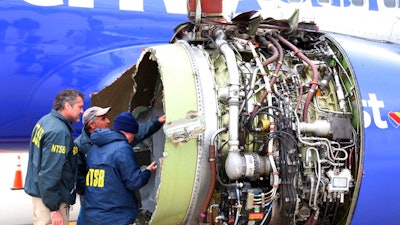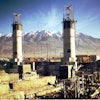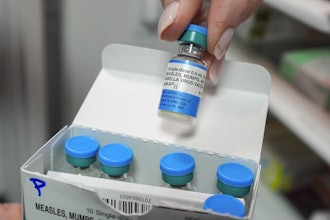
PHILADELPHIA (AP) — A preliminary examination of the blown jet engine of the Southwest Airlines plane that set off a terrifying chain of events and left a businesswoman hanging half outside a shattered window showed evidence of "metal fatigue," according to the National Transportation Safety Board.
Passengers scrambled to save the woman from getting sucked out the window that had been smashed by debris. She later died, and seven others were injured.
The pilots of the twin-engine Boeing 737 bound from New York to Dallas with 149 people aboard took it into a rapid descent Tuesday and made an emergency landing in Philadelphia. Oxygen masks dropped from the ceiling and passengers said their prayers and braced for impact.
"I just remember holding my husband's hand, and we just prayed and prayed and prayed," said passenger Amanda Bourman, of New York.
The dead woman was identified as Jennifer Riordan, a Wells Fargo bank executive and mother of two from Albuquerque, New Mexico. The seven other victims suffered minor injuries.
The National Transportation Safety Board sent a team of investigators to Philadelphia.
In a late night news conference, NTSB chairman Robert Sumwalt said one of the engine's fan blades was separated and missing. The blade was separated at the point where it would come into the hub and there was evidence of metal fatigue, Sumwalt said.
The engine will be examined further to understand what caused the failure. The investigation is expected to take 12 to 15 months.
Photos of the plane on the tarmac showed a missing window and a chunk gone from the left engine, including part of its cover. A piece of the engine covering was later found in Bernville, Pennsylvania, about 70 miles (112 kilometers) west of Philadelphia, Sumwalt said.
As a precaution, Southwest said Tuesday night that it would inspect similar engines in its fleet over the next 30 days.
Passengers praised one of the pilots, Tammie Jo Shults, for her cool-headed handling of the emergency. The former Navy pilot was at the controls when the plane made the emergency landing. She walked through the aisle and talked with passengers to make sure they were OK after the aircraft touched down.
"She has nerves of steel. That lady, I applaud her," said Alfred Tumlinson, of Corpus Christi, Texas. "I'm going to send her a Christmas card, I'm going to tell you that, with a gift certificate for getting me on the ground. She was awesome."
In a recording of conversations between the cockpit and air traffic controllers, an unidentified crew member reported that there was a hole in the plane and "someone went out."
Tumlinson said a man in a cowboy hat rushed forward a few rows to grab the woman and pull her back in.
"She was out of the plane. He couldn't do it by himself, so another gentleman came over and helped to get her back in the plane, and they got her," he said.
Passengers struggled to somehow plug the hole while giving the badly injured woman CPR.
As the plane came in for a landing, everyone started yelling to brace for impact, then clapped after the aircraft touched down safely, Bourman said.
Southwest CEO Gary Kelly said there were no problems with the plane or its engine when it was inspected on Sunday.
The jet's CFM56-7B engines were made by CFM International, jointly owned by General Electric and Safran Aircraft Engines of France. CFM said in a statement that the CFM56-7B has had "an outstanding safety and reliability record" since its debut in 1997.
Last year, the engine maker and the Federal Aviation Administration instructed airlines to make ultrasonic inspections of the fan blades of engines like those on the Southwest jet. The FAA said the move was prompted by a report of a fan blade failing and hurling debris. A Southwest spokeswoman said the engine that failed Tuesday was not covered by that directive, but the airline announced it would speed up ultrasonic inspections of fan blades of its CFM56-series engines anyway.
"There's a ring around the engine that is meant to contain the engine pieces when this happens," said John Goglia, a former NTSB member. "In this case it didn't. That's going to be a big focal point for the NTSB — why didn't (the ring) do its job?"
In 2016, a Southwest Boeing 737-700 blew an engine as it flew from New Orleans to Orlando, Florida, and shrapnel tore a 5-by-16-inch hole just above the wing. The plane landed safely. The NTSB said a fan blade had broken off, apparently because of metal fatigue.






















